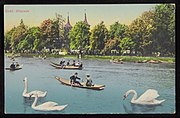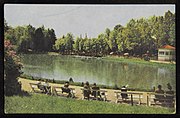Hilmtich
| Hilmtich | ||
|---|---|---|

|
||
| Hilchteich with Hilnteichschlössel | ||
| Geographical location | Graz , Austria | |
| Tributaries | Kroisbach (introduction) | |
| Drain | Kroisbach → Grazbach → Mur | |
| Data | ||
| Coordinates | 47 ° 5 '4 " N , 15 ° 27' 39" E | |
|
|
||
| Altitude above sea level | 377 m above sea level A. | |
| surface | 0.92 ha | |
| length | 170 m | |
| width | 40-70 m | |
| scope | 420 m | |
The Hilnteich is an artificial standing water in the Styrian capital Graz . Originally laid out as a clay pit , the brick pond developed into a popular local recreation area for the city's population.
Location and surroundings
The Hilnteich lies at 377 m above sea level. A. on the eastern edge of the III. Graz city district Geidorf , at the exit of the Mariatroster valley . The east and south banks are bordered by the Leechwald , which extends on a riedel north of the LKH University Hospital . In the forest, the brick- style Hilmwarte towers 54 m above the water . The pond is fed by a discharge from the Kroisbach , which also drains the area. The double stop Hilnteich / Botanischer Garten can be reached with the Graz lines 1 ( tram ) or 41 or 58 ( bus ).
fauna
Despite the great demand for local recreation, the Hilnteich has a considerable amount of water fauna. The fish stock is primarily made up of carp and aitel . Freshwater mites , yellow beetles , water beetles , back swimmers , water scorpions and pond clams can also be found in the water , and common toads , grass snakes and dragonflies on the banks . In addition to the numerically frequent Mallard are Krick- , Pintail and Shoveler and wagtail , smoke and House Martin encountered as food guests. In the past, you could occasionally see nutrias escaping from a fur farm.
etymology
The area between Kroisbach, Hilmgasse and today's Heinrichstraße was called "Auf der Hilm" or "Auf der Hülben (Hülm)" until the 19th century. This goes back to the Old High German word huliwa and its Middle High German modifications hülwe or hülbe , which mean something like swamp or puddle . The “Auf der Hilm” inn was located on Heinrichstrasse (then Mariatrosterstrasse). The place name “An der Hülben” can be traced back to the year 1354, but it is located in the vicinity of Graz. Around 1850 the name Hilmerteich came up, from which today's name developed.
In Styria, the village of Breitenhilm ( Vasoldsberg municipality ) in the Ferbersbachtal, which used to be partially swamped, and the Hilmberg near Friedberg with also swamped high meadows have the same name stem .
history

At the beginning of the 19th century there was the so-called Ziegelstadelwiese next to the pond surrounded by fields and meadows. The swampy area was only accessible via two narrow footpaths along the Kroisbach. There are hardly any records of the origin and history of the Hilnteich. Robert Baravalle, who could at least trace the ownership back to 1749, put forward the assumption in 1935 that the origin could be around 1570 in the fear of the impending " Turkish threat ". In the course of the fortifications, a clay pit would have been created, which was later abandoned, presumably because of a groundwater ingress.
At the time of Franziszeischer land survey (1829) was one of the area around the Ziegelteich a certain Franz Heibel (Heipel), "Fleischsölcher in Upper Geydorf" and was home to the gentry Waldegg (at Kirchbach ) and St. Joseph (Maria Trost) subservient . In addition to the large pond (1193 square fathoms ) there was a much smaller one (59 square fathoms ) at the point where the historic tram stop is located today. When a popular ice-skating pond had to be filled in with the construction of Elisabethstrasse in 1841, the Hilnte pond experienced its great upswing as an excursion destination. The diary entry of a woman from Graz described the impressions of a winter visit in 1851:
“When we reached Hilmerteich, a crowd of people was already gathered; fortunately we got a place from where we overlooked the whole thing. It is a strange sight! The snowy area shimmering in the rays of the sun - the big patch of ice on which the lively world of men frolicked - the small sledges on which beautiful girls sat with triumphant gaze - the happy music - in short a wonderful winter festival! "
After a small inn had already existed in the 1840s , the number of visitors continued to grow and landowner Heipel could no longer do justice to the hustle and bustle. On October 20, 1857, a purchase contract was signed with Hilmerteich- Aktiengesellschaft , which in the following years enlarged the pond by a good third, laid new paths and purchased rowing boats . In 1858, an elegant restaurant was built, the Hilnteichschlössel , which is now a listed building, which finally advanced the area from being a popular destination for ordinary people to the “glamorous epitome of city life”. A year later, a beer parlor with an ice cellar , the so-called “Schweizerhaus”, was built near the shore. In 1868 the city of Graz acquired the entire area and organized regular concerts with military bands .
Leisure activities
In addition to rowing boats in summer and ice skating in winter, you can go fishing all year round . In addition to carp , which have been recorded as early as 1854, the Hilnteich contains pikeperch , tench , rudd , roach , bitterlings , signal crabs , perch and sturgeon . To ensure the cleanliness of the water, the pond is regularly drained and cleaned. In addition, the Hilnteich, which can be circled on a promenade in a few minutes, is a popular starting point for walks through the Leechwald or to Mariatrost as well as hikes to Mariazell . The R 23 state cycle route starts at Hilnteich and leads to Mariatrost.
Between 1950 and 2011, the Schweizerhaus housed the premises of the Kummer dance school , which has since become the largest dance school in Austria. In the immediate vicinity, a high ropes course opened in 2008 between the trees of the Leechwald .
- Historical postcards
Web links
Individual evidence
- ↑ Water book excerpt Holding Graz 1/90. State of Styria , accessed on October 17, 2017 .
- ↑ Digital Atlas of Styria: Address and map. (No longer available online.) State of Styria , archived from the original on June 15, 2012 ; accessed on October 17, 2017 . Info: The archive link was inserted automatically and has not yet been checked. Please check the original and archive link according to the instructions and then remove this notice.
- ^ Department of Property Management of the City of Graz & Berg- und Naturwacht Steiermark (Ed.): Leechwald Forest Trail. Graz 2000, pp. 16-17.
- ↑ a b c d e Robert Baravalle: The Hilmtich and its history. In: Blätter für Heimatkunde. Vol. 13 (1935), No. 6, pp. 85-89.
- ↑ a b c Robert Engele: At that time in Graz. A city tells its story. Styria , Graz 2010, Ed. Kleine Zeitung , pp. 78–80. ISBN 978-3-222-13286-5 .
- ↑ Verena Schleich: Fishing in troubled waters was yesterday. Week, November 18, 2010, accessed October 22, 2017 .
- ↑ Teresa Schauer-Wünsch: The end of a Graz era: the end of dance school grief. Die Presse , February 17, 2011, accessed on October 22, 2017 .







